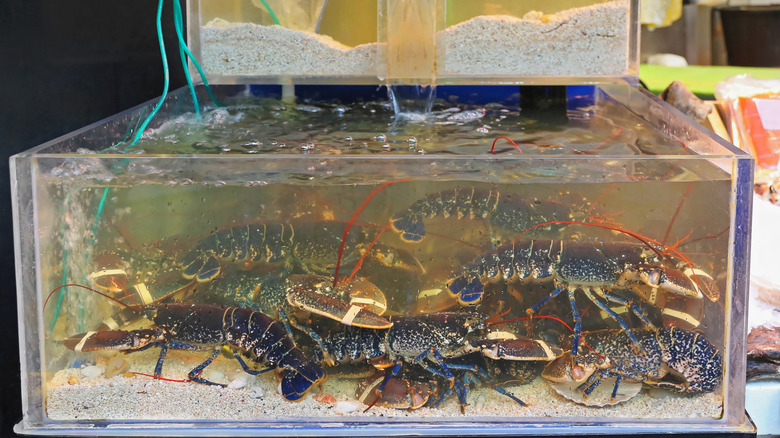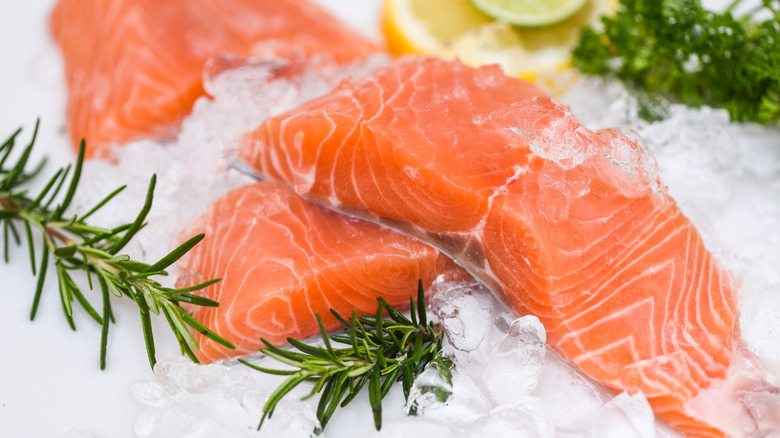11 Signs You're In A Bad Seafood Restaurant
Not all seafood restaurants are created equal, and more worryingly, not all deliver on their claims of "fresh," "ethically sourced," or "in season." So, while seafood lovers can enjoy some of the most extraordinary dining experiences at restaurants, they can also be faced with overpriced menus or subpar food. Signs like rubbery calamari or extremely cheap lobsters are obvious red flags, but there are plenty of other signs that suggest a seafood spot should be avoided.
For a deeper look into this, we've tapped three experts who know seafood and seafood restaurants. Mazen Mustafa, the executive chef at The Lonely Oyster restaurant in Los Angeles, brings finesse and a bold approach to fresh, sustainable seafood. Chef Miguel Olmedo — a sushi fan and award-winning chef instructor at the Auguste Escoffier School of Culinary Arts — shares decades of experience, while Desiree Antczak, Senior Sales Account Manager at Wulf's Fish, brings her expertise working directly with chefs to source the best seafood for their menus. Their invaluable insights will help you suss out the good, the bad, and the fishy at seafood restaurants before it's too late.
The smell is too 'fishy'
The last thing you should be smelling when you step into a seafood restaurant is fish. Sounds contradictory? Well, there's a fish smell that is 'good' — i.e. salty, fresh, grilled, and subtle — and then there's the foul, funky odor that assaults you when seafood is off or past its prime. "You never want to walk into any restaurant and be hit with an off-putting odor. This is especially true with seafood," says Desiree Antczak.
Any such smell is an immediate red flag that the meal you order may not be optimal (at best), or could cause severe food poisoning (at worst). Alternatively, if instead of rotten fish you smell ammonia or bleach, this does not necessarily mean that you've found an extremely well-cleaned eatery. Rather, it could indicate an overuse of cleaning products to mask foul odors.
However, a strong fish smell does not automatically mean it's a lousy restaurant. A little leeway should be given if you are dining at a restaurant that is near an ocean or river where the fish are being caught fresh, according to Miguel Olmedo. "Seafood restaurants that are inland will have a cleaner, fresher smell. Seafood restaurants close to the coast and/or a body of water will have a stronger seafood odor," Olmedo said. Use your judgment in such circumstances, and keep an eye out for any other warning signs.
A messy live-seafood tank
There's a type of seafood restaurant that displays its fresh catch in tanks to entice patrons. These tanks often hold a variety of fish and crustaceans, and customers can pick and choose what they want to eat. In theory, this assures you of the quality and freshness of the seafood before it's cooked, adding to the whole dining experience.
However, maintaining these large tanks and cleaning them regularly is no easy feat. If not done properly or well, tank maintenance can result in unhygienic conditions, and look pretty dismal too. Chef Mazen Mustafa advises checking that "the tank doesn't have any odor or indication of foul seafood." It's also important to see that lobsters are actively moving within the water.
Some customers may question whether storing seafood this way is even necessary. Certain shellfish actually do need to be kept alive until being cooked, as they decompose rapidly. So, if the seafood you spot in a restaurant's tank is not too crowded, and the water is clear and clean, odds are the seafood you will be served will be as fresh as you can get. Nonetheless, keep an eye out for other signs that your seafood is not fresh, and check online reviews for any negative reports.
Unclear or unethical seafood sourcing
While much has been reported about the unethical rearing of farm animals, not enough has been said about the dark side of seafood sourcing. The seafood industry is notorious for irresponsible practices. These include overfishing, oceanic pollution, targeting endangered species, and damaging the marine ecosystem.
When it comes to seafood, knowing what you are eating and where it comes from matters. If the restaurant does not have clear answers to your questions about where the ingredients are sourced from, it's worth pausing and asking yourself how much you want that platter of oysters or plate of fish and chips.
Seafood fraud is a very real issue as well. There is a chance that the fish being served isn't what you think it is. Fish are mislabeled or swapped for cheaper options. So, be aware that restaurants may engage in fish substitution, and you end up paying exorbitant prices for the type of fish that you are actually being served. This can also be dangerous for diners with allergies. It pays to be cautious and alert at all times.
Off-season or limited fish selection
A top-notch seafood restaurant will always serve a variety of seasonal seafood, year-round. On the other hand, according to Miguel Olmedo, "a restaurant that doesn't specialize in fresh seafood ... [may] have the typical universal selections of tilapia, ahi tuna, and/or salmon. These are commonly bought pre-cut and vacuum sealed, not fresh."
A good seafood restaurant will offer a well-curated menu that changes with seasonal availability. However, an eatery's use of frozen fish is not necessarily a dealbreaker. "There are seafood restaurants hundreds of miles from the coast that have good relationships with their purveyors, and have some of the best seafood in the world flown in," explains Desiree Antczak. "And there are restaurants right on the coast who buy cheap, inferior products."
A restaurant that changes its specials with the season is likely committed to quality, whereas one with a menu that rarely changes is more likely to rely on frozen seafood. Another red flag to look out for is an overabundance of condiments on fish dishes. Chef Miguel Olmedo warns that this is a technique that "restaurants use to hide inferior, old seafood ... they cover it with an acidic sauce and/or relish." And while an eatery's use of freshly caught seafood is a green flag, if it'll be served uncooked, this raises potential problems. Be aware of the safety mistake to avoid when making ceviche — restaurant management needs to use the right kind of fish for that dish.
Fish feels mushy or is too dry
Fish can vary in texture, but generally, cooked seafood should have a pleasant firmness to the touch. A light spring in the texture implies respect for and expert handling of the protein. If the fish on your plate is too soft, odds are the fish was frozen and not thawed correctly. To prevent mushiness in fish, it needs to be defrosted slowly in a refrigerator to maintain its structure. Failure to do this can result in a sloppy, soggy mess. Another reason this can happen may be the result of over-marination, as letting seafood spend too long in an acidic liquid could lead to a breakdown of the protein structure.
On the other hand, if the fish on your plate seems too dry, this could indicate another issue, according to Mazen Mustafa. "Dryness or overcooked fish are usually signs of masking a problem, or reheating a dish for a second time," he said. A reputable seafood restaurant will always take pride in the quality of its dishes, so if you encounter either of these characteristics, politely inquire about the preparation of the dish, and request a replacement. Even if your server insists that the dish is fine, trust your instincts.
Fish is served without skin or only fried
A seafood restaurant with only fried items on its menu may not be the high-quality establishment you are after. While there's nothing wrong with a heaping plate of well-prepared, super-crispy fish, if deep-fried dishes are the only items on the menu, the restaurant may not be equipped to handle more complicated recipes — or even worse, it may be masking the poor quality of its offerings.
An overabundance of fried seafood is not the only indicator that something is wrong. Ultimately, it comes down to balance. Chefs who are confident of the quality of their ingredients pay attention to little details, like which fish to cook with the skin on. Leaving the skin on helps retain moisture and flavor. If a restaurant consistently serves skinless fillets (especially of fish like snapper or sea bass, which have delicious edible skin), this could indicate that the kitchen receives its supply pre-filleted and processed.
Of course, presentation and details like crispy skin and boneless fillets depend on the type of seafood restaurant and cuisine it serves. Chinese or Mediterranean kitchens frequently serve whole fish, while other restaurants opt for boneless darnes. Regardless of the style, a restaurant that offers different cooking techniques is a sign that the kitchen team is committed to exceptional quality and craftsmanship.
Mixed or bad reviews
Many people check online reviews before choosing a restaurant. But how legit are these reviews in the first place? Can you believe everything you read online? (Spoiler: no.)
So, who should you trust? Well, our advice is to proceed with caution. If a restaurant has a ton of bad reviews, check out what exactly is being dissed. Is it the cleanliness? The service? Was a particular dish below the mark? If most of the reviews are positive with a few negative comments, that could be due to a matter of personal taste or a few particularly picky customers. On the flip side, if all the reviews are glowing, they should be scrutinized as well. Online review platforms should take responsibility for providing genuine information — for example, Yelp has cracked down on fake restaurant reviews (both positive and negative) — in an effort to provide the most useful feedback to their readers.
Restaurant PR teams work tirelessly to ensure that the establishment is portrayed in the best possible light. Bloggers and influencers receive free meals (along with top-tier service) in exchange for a good review. These inflated recommendations might not be the everyday norm, so it pays to check what others are saying before you buy into the hype. Of course, nothing beats real word-of-mouth recommendations from trusted friends and family. In such situations, your chances of having a great dining experience improve considerably.
Hygiene issues or dirty toilets
There are obvious red flags when it comes to proper hygiene and cleanliness at any eatery. A glance at the dining room can tell you more in a minute than any health-inspection report could. If you find yourself in a restaurant that has dusty floors, sticky tables, cloudy glassware, unkempt staff uniforms, and smelly bathrooms, it's time to leave. A dirty restaurant menu is a red flag, as well. There's no excuse for such hygienic lapses, and it is indicative of the lack of care paid to the safety of a restaurant's staff and patrons.
The trend of restaurants featuring open kitchens offers diners a glimpse into how their food is being prepared, making good hygiene even more important. Kitchens are notoriously tough to keep clean, and a good restaurant has to be on top of its game when it comes to keeping everything mopped, swabbed, wiped down, and grease-free. Maintaining proper storage facilities and allergen-free environments is non-negotiable. The hospitality industry has to observe strict safety guidelines to minimize risk and ensure a safe dining experience. Poor health-inspection ratings are also worth taking into consideration when choosing a restaurant.
Finally, in any establishment other than a fast food joint, presentation matters. A beautifully plated dish reflects the kitchen team's attention to detail and craftsmanship, making diners feel valued. A lack of effort, on the other hand, tends to make diners feel overlooked and unappreciated.
Prices are too low or too high
Pricing at restaurants — especially seafood eateries — is always a tricky matter. If prices are high, the meal, service, and ambience had better justify the cost. Prices that are too low will make you wonder if the place is serving subpar food.
If a restaurant charges a premium but fails to deliver, this may create an inflated sense of value, and can lead to dissatisfaction and bad reviews. Higher prices can be justified by factors such as exclusive ingredients, a great location, or a renowned chef. However, if a menu offers items like crab or salmon at bargain prices, you should be instantly suspicious — seafood is often mislabeled, and there's a chance the restaurant is pulling a bait-and-switch operation. As Mazen Mustafa states, "if it seems too good to be true, it is."
Seafood restaurants also frequently feature items offered at what is called "market price," which reflects the cost of a fresh catch. "Customers should stay away from market-price seafood specials if the seafood being sold is not in season," says Miguel Olmeda. To avoid an unpleasant surprise when the bill arrives, check reviews in advance for any complaints about overpricing at the restaurant.
Numerous non-seafood items on the menu
The last thing you'd expect from a great seafood restaurant is a long list of non-seafood items on the menu. A few dishes for those who don't eat seafood are understandable, but when the menu is packed with burgers, steaks, sandwiches, and pasta, this may not be the seafood specialty restaurant you are looking for.
Even some dishes that include fish are best avoided. Seafood pasta is widely considered as one of the menu items you should never order at a seafood restaurant. Since pasta is generally less expensive than fish, seafood pasta dishes provide an easy way to maximize profits while using minimal seafood, or even as a way to use up seafood scraps. Another warning sign may be overabundant servings of seafood — Desiree Antczak informs us that "if a restaurant is offering deals like 'all you can eat,' it could mean they're shopping the market looking for closeout deals on items that are past their best-by date, or perhaps produced in less-than-ideal conditions."
An extra-large menu can be a red flag at seafood restaurants. Chefs ideally provide a small selection of appetizers and desserts, with the main courses taking center stage. Too many extras are just distractions from the real stars of the show — the freshly prepared seafood. A huge menu also makes it harder to execute dishes well, and if a seafood restaurant is trying to do too many things, it may end up not excelling in any of them.
The restaurant is empty or the staff doesn't care
At the end of the day, there's a lot more to a great dining experience than just the food. Service plays a huge role in shaping your meal, especially when you are willing to pay a premium for it. If the staff acts indifferent — or worse, unpleasant — it affects how welcome you feel.
Other factors — like poor hygiene, unkempt uniforms, inattentiveness, or rude behavior — can make the meal a nightmare, even if the food is great. A well-run restaurant ensures a smooth experience from the moment you walk in, with staff members who greet you at the door, help with the seating, explain the specials, introduce the wine list, and engage in small pleasantries. If none of this happens, it indicates poor training and a lack of proper supervision.
Another tip-off is an empty restaurant during peak dining hours. A seafood place with no other customers during the weekend likely suffers from poor food, bad service, or extravagant pricing. Low demand also raises concerns about the freshness of the seafood. Ultimately, the vibe does matter. Dining in a dead, empty restaurant is never a pleasant experience, and can feel awkward instead of enjoyable. A good restaurant should feel welcoming, lively, and well-managed. If it's not, you'll probably want to take your appetite (and your wallet) elsewhere.











